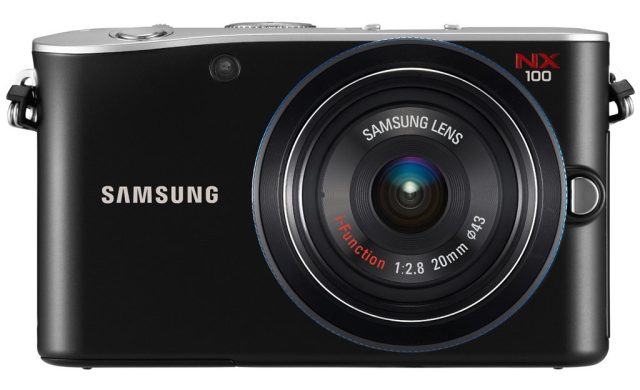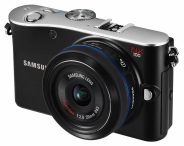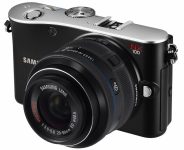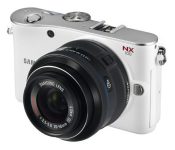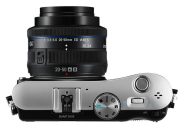Announced
Production status
System
Samsung NX100
APS-C AF digital mirrorless camera • Discontinued
Specification
| Format: | |
| APS-C | |
Imaging sensor: | 23.4 × 15.6mm CMOS sensor |
Resolution: | 4592 × 3056 - 14 MP |
Crop factor: | 1.54x |
Sensor-shift image stabilization: | - |
| Samsung NX [25.5mm] | |
| Shutter: | |
Type: | Focal-plane |
Model: | Electronically controlled |
Speeds: | 30 - 1/4000 + B |
| Exposure: | |
Exposure metering: | Through-the-lens (TTL), open-aperture |
Exposure modes: | Programmed Auto |
| Aperture-priority Auto | |
| Shutter-priority Auto | |
| Manual | |
| Physical characteristics: | |
Weight: | 282g |
Dimensions: | 120.5x71x34.5mm |
Manufacturer description
LONDON, UK – September 14, 2010 - Samsung Electronics (UK) Ltd today announces the launch of the unique Samsung NX100 – an innovative mirrorless camera equipped with the world’s first i-Function lens, putting the perfect picture at the fingertips of all photographers through a completely new way of controlling your camera.
The NX100 is set to dominate the new mirrorless camera category. This innovative new camera benefits from Samsung’s expertise across multiple areas of technology, meaning that all its key components are 100% produced by Samsung. This unique process has been combined with Samsung’s detailed and extensive program of consumer research, which provided valuable insights to incorporate into the NX100. The NX100 is also complemented by an extensive line up of lenses and accessories, giving photographers a full package of options with which to explore their creativity.
The launch of the NX100 follows the success of the NX10, Samsung’s first mirrorless camera and the first in the world to feature an APS-C size sensor, which has already changed the way millions of photographers across the globe take pictures, and raised the bar for the industry as a whole. The NX100 shares the industry leading technology of the NX10, such as an APS-C size sensor for quality images and a 3-inch AMOLED screen for clear and easy viewing. However, Samsung takes the mirrorless camera to the next level with the NX100, by incorporating the innovations of the NX10 and improving other areas of the camera’s performance and design. The body of the camera is slim, sleek and stylish, and it also features the intuitive i-Function lens which allows users to control their camera through the lens for the first time. The NX100 also boasts one of the fastest AF on the market today, which ensures that users never miss a moment, as well as an ISO that is raised to a maximum of 6400 for action shots.
The NX100’s shutter button and curved body have been inspired to an attractive natural shape. The lightweight, compact and modern design makes the camera extremely portable, allowing users with a creative flair to carry the NX100 with them anywhere and for any occasion. The NX100 is more than just a camera; it is both a creative tool and an artistic object that makes a bold style statement everywhere it goes.
Mr. SangJin Park, President of Samsung Digital Imaging Division, Samsung Electronics, commented: “Our aim is to lead the mirrorless camera market in the same way we do the DualView category, and the new NX100 is the embodiment of that goal. Samsung has brought together this high quality of imaging technology with intuitive consumer insights based on our in-depth consumer research, which is why we believe that, alongside the NX10, the NX100 will enhance our position in this growing field. Our unique and pioneering i-Function Lens stands out from the competition as an example of our unparalleled innovation which will appeal to every photographer.”
While conventional lenses are passive in controlling camera settings, the unique i-Function Lens is a proactive lens that communicates with the camera body. It delivers total image control with fast manual settings to ensure quick and easy image capture, and also provides customized settings optimized for the lens being used. The lens incorporates an i-Function button which allows users to scroll through manual settings, and a focus ring which is used to easily change parameters for each setting. Users can toggle between shutter speed, aperture, EV, WB, and ISO quickly and easily by simply using the i-Function button and ring on the lens, meaning easier and quicker configuration while shooting.
The NX100 also has a lens priority mode which makes switching between lenses easier than ever. Firstly, each lens is clearly marked with icons that illustrate their main use to help users quickly learn which lens they need to select for any given scene. The lens priority mode provides scene options optimized for the lens being used – for example when a landscape lens is attached the camera will immediately display the landscape mode. Also, when users change to a specialized lens, the camera would recognize the lens type and automatically configure the settings that would best match with the attached lens. Note this latter feature is supported fully on future specialised Samsung lenses.
The NX100’s innovations aren’t confined to the lens – the camera also provides a very creative feature called ‘Smart Filter’. In playback mode, users can apply seven different effects to the picture, such as the vignette, soft focus, fish-eye or miniature effects. The ‘Smart Filter’ provides not just high quality images, but also features that are fun to use.
The fun doesn't stop with still images. The NX100 supports HD movie recording at 720P, to capture the finest details of your memories. It also contains a ‘Sound Picture’ mode that can record audio whilst a photo is taken. To ensure each image is perfect quality, even when lenses are being changed regularly, the NX100 also features a supersonic dust reduction feature to remove any foreign particles from the lens before shooting.
At launch the NX100 will be equipped with a range of innovative lenses and accessories including a compact zoom 20-50mm lens, a small and light 20mm wide angle Pancake lens (to be introduced shortly after launch). Two additional specialized lenses will be made available in the first half of 2011 – a 60mm Macro lens and 18-200mm Super Zoom lens. To expand the lens line-up even further, three more lenses will be introduced by the second half of 2011. The NX system will be further enhanced with more accessories, including an Electronic Viewfinder, Flash and GPS tracker to capture your exact geographical location.
